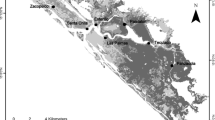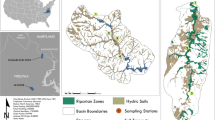Abstract
Anthropogenic land use has significantly altered sediment and nutrient dynamics at watershed-scales, resulting in significant redeposition within large floodplain ecosystems. Some upland land uses have had documented negative effects on soil carbon (C) stocks, although the specific impacts of these disturbances on soil organic carbon (SOC) dynamics in depositional environments are poorly understood. Assessment of SOC stocks in floodplain environments will allow for more precise estimates of C distribution at watershed and regional scales. In this study, we measured SOC pools to depths of 100 and 200 cm in four distinct floodplain landscapes (natural levee, flats, mineral wetlands, organic wetlands) in a large bottomland forest within Congaree National Park, South Carolina, USA. Mean SOC stocks to a depth of 100 cm were 108–109 Mg C ha−1 in flats and levees, 193 Mg C ha−1 in mineral wetlands, and 533 Mg C ha−1 in organic wetlands. In addition, hydric soils contained significantly more SOC in deep horizons (100–200 cm depths). At a regional scale, similar alluvial soils within large floodplains were estimated to store approximately 0.l Pg of SOC. These results highlight the importance of inclusion of deep SOC storage in alluvial settings when estimating watershed C budgets.




Similar content being viewed by others

References
Allen BP, Sharitz RR, Goebel PC (2005) Twelve years post-hurricane liana dynamics in an old-growth southeastern floodplain forest. Forest Ecology and Management 218:259–269
Amador JA, Görres JH, Savin MC (2005) Role of soil water content in the carbon and nitrogen dynamics of Lumbricus terrestris L. burrow soil. Applied Soil Ecology 28:15–22
Batjes NH (1996) Total carbon and nitrogen in the soils of the world. European Journal of Soil Science 47:151–163
Blake GR, Hartge K (1986) Bulk density. In: Klute A (ed) Methods of soil analysis. Part 1. Physical and mineralogical methods, 2nd edn. Agronomy monograph 9. ASA and SSSA, Wisconsin, pp 363–375
Blazejewski GA, Stolt MH, Gold AJ, Gurwick N, Groffman PM (2009) Spatial distribution of carbon in the subsurface of riparian zones. Soil Science Society of America Journal 73:1733–1740
Bridgham SD, Megonigal JP, Keller JK, Bliss NB, Trettin C (2006) The carbon balance of North American wetlands. Wetlands 26:889–916
Carter BJ, Kelley JP, Sudbury JB, Splinter DK (2009) Key aspects of A horizon formation for selected buried soils in late Holocene alluvium; southern prairies, USA. Soil Science 174:408–416
Cavalcanti GG, Lockaby BG (2005) Effects of sediment deposition on fine root dynamics in riparian forests. Soil Science Society of America Journal 69:729–737
Cierjacks A, Kleinschmit B, Kowarik I, Graf M, Lang F (2011) Organic matter distribution in floodplains can be predicted using spatial and vegetation structure data. River Research and Applications 27:1048–1057
Clawson RG, Lockaby BG, Rummer R (2001) Changes in production and nutrient cycling across a wetness gradient within a floodplain forest. Ecosystems 4:126–138
Cole JJ, Prairie YT, Caraco NF, McDowell WH, Tranvik LJ, Striegl RG, Duarte CM, Kortelainen P, Downing JA, Middelburg JJ, Melack J (2007) Plumbing the global carbon cycle: integrating inland waters into the terrestrial carbon budget. Ecosystems 10:171–184
Davis AA, Stolt MH, Compton JE (2004) Spatial distribution of soil carbon in southern New England hardwood forest landscapes. Soil Science Society of America Journal 68:895–903
Dixon RK, Brown S, Houghton RA, Solomon AM, Trexler MC, Wisniewski J (1994) Carbon pools and flux of global forest ecosystems. Science 263:185–191
Eswaran H, Van Den Berg E, Reich P (1993) Organic carbon in soils of the world. Soil Science Society of America Journal 57:192–194
Fry J, Xian G, Jin S, Dewitz J, Homer C, Yang L, Barnes C, Herold N, Wickham J (2011) Completion of the 2006 National Land Cover Database for the Conterminous United States. Photogrammetric Engineering and Remote Sensing 77:858–864
Gee GW, Bauder JW (1986) Particle-size analysis. In: Klute A (ed) Methods of soil analysis. Part 1. Physical and mineralogical methods, 2nd edn. Agronomy monograph 9. ASA and SSSA, Wisconsin, pp 383–411
Groffman PM, Butterbach-Bahl K, Fulweiler RW, Gold AJ, Morse JL, Stander EK, Tague C, Tonitto C, Vidon P (2009) Challenges to incorporate spatially and temporally explicit phenomena (hotspots and hot moments) in denitrification models. Biogeochemistry 93:49–77
Grossman RB, Harms DH, Kuzila MS, Glaum SA, Hartung SL, Fortner JR (1998) Organic carbon in deep alluvium in southeast Nebraska and northeast Kansas. In: Lal R, Kimble JM, Follett RF, Stewart BA (eds) Soil processes and the carbon cycle. Advances in Soil Science. CRC Press, Massachusetts, pp 45–56
Gurwick NP, Groffman PM, Yavitt JB, Gold AJ, Blazejewski G, Stolt MH (2008) Microbially available carbon in buried riparian soils in a glaciated landscape. Soil Biology and Biochemistry 40:85–96
Hupp CR, Pierce AR, Noe GB (2009) Floodplain geomorphic processes and environmental impacts of human alteration along Coastal Plain rivers, USA. Wetlands 29:413–429
Izaurralde RC, Williams JR, Post WM, Thomason AM, McGill WB, Owens LB, Lal R (2007) Long-term modeling of soil C erosion and sequestration at the small watershed scale. Climatic Change 80:73–90
Jackson ML (2005) Soil chemical analysis: advanced course. Revision of the 2nd edn. 11th printing. Parallel Press, Wisconsin
Jacobson RB, Coleman DJ (1986) Stratigraphy and recent evolution of Maryland Piedmont flood plains. American Journal of Science 286:617–637
Jobbágy EG, Jackson RB (2000) The vertical distribution of soil organic carbon and its relation to climate and vegetation. Ecological Applications 10:423–436
Jolley RL, Lockaby BG, Governo RM (2010) Biogeochemical influences associated with sedimentation in riparian forests of the Southeastern Coastal Plain. Soil Science Society of America Journal 74:326–336
Karlen DL, Mausbach MJ, Doran JW, Cline RG, Harris RF, Schuman GE (1997) Soil quality: a concept, definition, and framework for evaluation (a guest editorial). Soil Science Society of America Journal 61:4–10
Kern JS (1994) Spatial patterns of soil organic carbon in the contiguous United States. Soil Science Society of America Journal 58:439–455
Kuhry P, Vitt DH (1996) Fossil carbon/nitrogen ration as a measure of peat decomposition. Ecology 77:271–275
Lal R (2003) Soil erosion and the global carbon budget. Environment International 29:437–450
Lal R (2005) Forest soils and carbon sequestration. Forest Ecology and Management 220:242–258
Lockaby BG (2009) Floodplain ecosystems of the Southeast: linkages between forests and people. Wetlands 29:407–412
Mausbach MJ, Richardson JL (1994) Biogeochemical processes in hydric soil formation. Current Topics in Wetland Biogeochemistry 1:68–127
McCarty G, Pachepsky Y, Ritchie J (2009) Impact of sedimentation on wetland carbon sequestration in an agricultural watershed. Journal of Environmental Quality 38:804–813
Meersmans J, De Ridder F, Canters F, De Baets S, Van Molle M (2008) A multiple regression approach to assess the spatial distribution of soil organic carbon (SOC) at a regional scale (Flanders, Belgium). Geoderma 143:1–13
Meybeck M (1993) Riverine transport of atmospheric carbon: sources, global typology and budget. Water, Air, and Soil Pollution 70:443–463
Mishra U, Lal R, Slater B, Calhoun F, Liu D, Can Meirvenne M (2009) Predicting soil organic carbon stock using profile depth distribution functions and ordinary kriging. Soil Science Society of America Journal 73:614–621
Nelson WM, Gold AJ, Groffman PM (1995) Spatial and temporal variation in groundwater nitrate removal in a riparian forest. Journal of Environmental Quality 24:691–699
Noe GB, Hupp CR (2009) Retention of riverine sediment and nutrient loads by Coastal Plain floodplains. Ecosystems 12:728–746
Post WM, Pastor J, Zinke PJ, Stangenberger AG (1985) Global patterns of soil nitrogen storage. Nature 317:613–616
Ricker MC, Donohue SW, Stolt MH, Zavada MS (2012) Development and application of multi-proxy indices of land use change for riparian soils in southern New England, USA. Ecological Applications 22:487–501
Ricker MC, Stolt MH, Donohue SW, Blazejewski GA, Zavada MS (2013) Soil organic carbon pools in riparian landscapes of southern New England. Soil Science Society of America Journal 77:1070–1079
Rumpel C, Kögel-Knabner I (2011) Deep soil organic matter – a key but poorly understood component of terrestrial C cycle. Plant and Soil 338:143–158
Schlesinger WH (1997) Biogeochemistry: an analysis of global change, 2nd edn. Academic Press, California
Schoeneberger PJ, Wysocki DA, Benham EC, Broderson WD (2002) Field book for describing and sampling soils, Version 2.0. Natural Resources Conservation Service, National Soil Survey Center, Lincoln
Soil Survey Staff (2013) Web soil survey: Soil data mart. Natural Resources Conservation Service, Washington, D.C. http://websoilsurvey.nrcs.usda.gov. Accessed 14 Jul 2013
Soil Survey Laboratory Staff (2004) Soil survey laboratory methods manual. Soil survey investigation report no. 42 version 4.0. United States Department of Agriculture, Government Printing Office, Washington D.C
Stallard RF (1998) Terrestrial sedimentation and the carbon cycle: coupling weathering and erosion to carbon burial. Global Biogeochemical Cycles 12:231–257
Tockner K, Stanford JA (2002) Riverine flood plains: present state and future trends. Environmental Conservation 29:308–330
Trimble SW (2008) Man-induced soil erosion on the southern Piedmont, 2nd edn. Soil and Water Conservation Society, Iowa
Walter RC, Merritts DJ (2008) Natural streams and the legacy of water-powered mills. Science 319:299–304
Wohl E, Dwire K, Sutfin N, Polvi L, Bazan R (2012) Mechanisms of carbon storage in mountainous headwater rivers. Nature Communications 3:1263
Zehetner F, Lair GJ, Gerzabek MH (2009) Rapid carbon accretion and organic matter pool stabilization in riverine floodplain soils. Global Biogeochemical Cycles 23:GB400
Acknowledgments
The authors are grateful for field and laboratory assistance provided by Robin Governo, Andrew Parsons, Russell Miller, Robert Price, Lauren Behnke, Theresa Thom, Ed Schenk, Cliff Hupp, David Shelley, and Frank Henning. We are also grateful to Drs. William Conner, Joey Shaw, and Yucheng Feng who helped improve draft versions of this manuscript. Funding and support for this research was provided by the United States Geological Survey and the United States National Park Service.
Author information
Authors and Affiliations
Corresponding author
Rights and permissions
About this article
Cite this article
Ricker, M.C., Lockaby, B.G. Soil Organic Carbon Stocks in a Large Eutrophic Floodplain Forest of the Southeastern Atlantic Coastal Plain, USA. Wetlands 35, 291–301 (2015). https://doi.org/10.1007/s13157-014-0618-y
Received:
Accepted:
Published:
Issue Date:
DOI: https://doi.org/10.1007/s13157-014-0618-y



